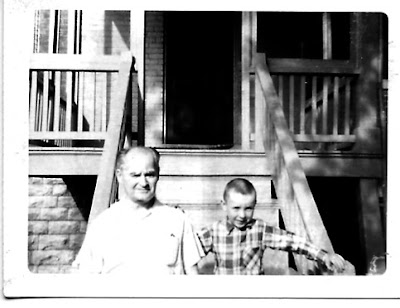
From the department of "Nostalgia isn't what it used to be," here's a piece I wrote back in 1986:
 It was probably 1965. My memories of life up to that point consist of black and white photographs with scalloped edges. I remember my grandmother’s white hair and black dress, Superman in a gray costume, the Beatles in black, collarless suits with their four black moptops and white winter snow covering everything in oh so black nights.
It was probably 1965. My memories of life up to that point consist of black and white photographs with scalloped edges. I remember my grandmother’s white hair and black dress, Superman in a gray costume, the Beatles in black, collarless suits with their four black moptops and white winter snow covering everything in oh so black nights.
The Beatles. The Fab Four. In my mind those four black and white Beatles are not the same as the ones who would emerge after that. While there was no single moment of transition, the second half of the 1960’s was most definitely in color…psychedelic color in fact. I remember school in colors—comic books, record albums and action figures, too. In essence, my childhood from age six.
Television was almost completely in color by the time we were able to watch it in 1968. I’ve seen so many pre-’68 shows in color since then that I "remember" them in color even though I originally saw them in black and white. Most movies were also in color by that same period with black and white becoming a novelty. Black and white became rare…and therefore precious.
I recall real life from 1966, too, in bright, vibrant colors that logic tells me could never really have existed. Indescribably blue skies and golden mornings—all of which I lived through and yet none of which passed in quite the way I recall.
In the beginning of MGM’s WIZARD OF OZ, Dorothy lives in a black and white world but longs for the beautiful, colorful world she knows just has to exist somewhere over the rainbow. The fact that she even knows what a rainbow is indicates that her world was never really as dull as she believed it to be.When she reaches her goal, her objective immediately becomes to return to her "simpler" life. It seems impossible but she perseveres and finally does return. A sad psychological case, perhaps, but an interesting metaphor for nostalgia.
Elvis Costello wrote, "There’ll never be days like that again…" In fact, there never were…but there are now.
The Beatles. The Fab Four. In my mind those four black and white Beatles are not the same as the ones who would emerge after that. While there was no single moment of transition, the second half of the 1960’s was most definitely in color…psychedelic color in fact. I remember school in colors—comic books, record albums and action figures, too. In essence, my childhood from age six.
Television was almost completely in color by the time we were able to watch it in 1968. I’ve seen so many pre-’68 shows in color since then that I "remember" them in color even though I originally saw them in black and white. Most movies were also in color by that same period with black and white becoming a novelty. Black and white became rare…and therefore precious.
I recall real life from 1966, too, in bright, vibrant colors that logic tells me could never really have existed. Indescribably blue skies and golden mornings—all of which I lived through and yet none of which passed in quite the way I recall.
In the beginning of MGM’s WIZARD OF OZ, Dorothy lives in a black and white world but longs for the beautiful, colorful world she knows just has to exist somewhere over the rainbow. The fact that she even knows what a rainbow is indicates that her world was never really as dull as she believed it to be.When she reaches her goal, her objective immediately becomes to return to her "simpler" life. It seems impossible but she perseveres and finally does return. A sad psychological case, perhaps, but an interesting metaphor for nostalgia.
Elvis Costello wrote, "There’ll never be days like that again…" In fact, there never were…but there are now.

me likey...
ReplyDelete